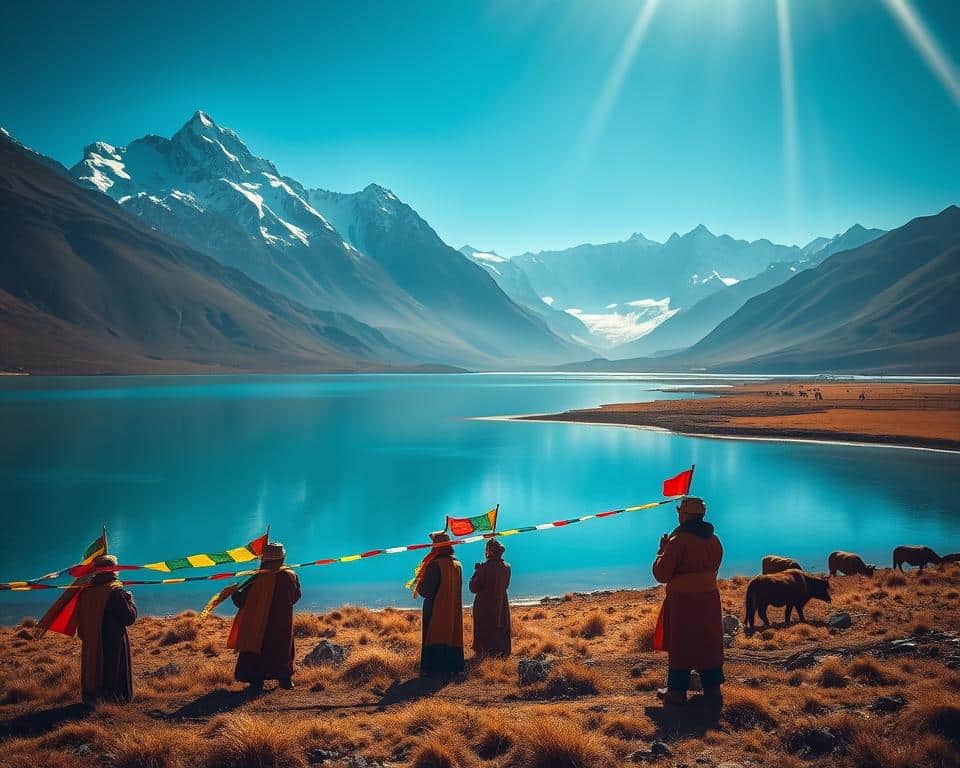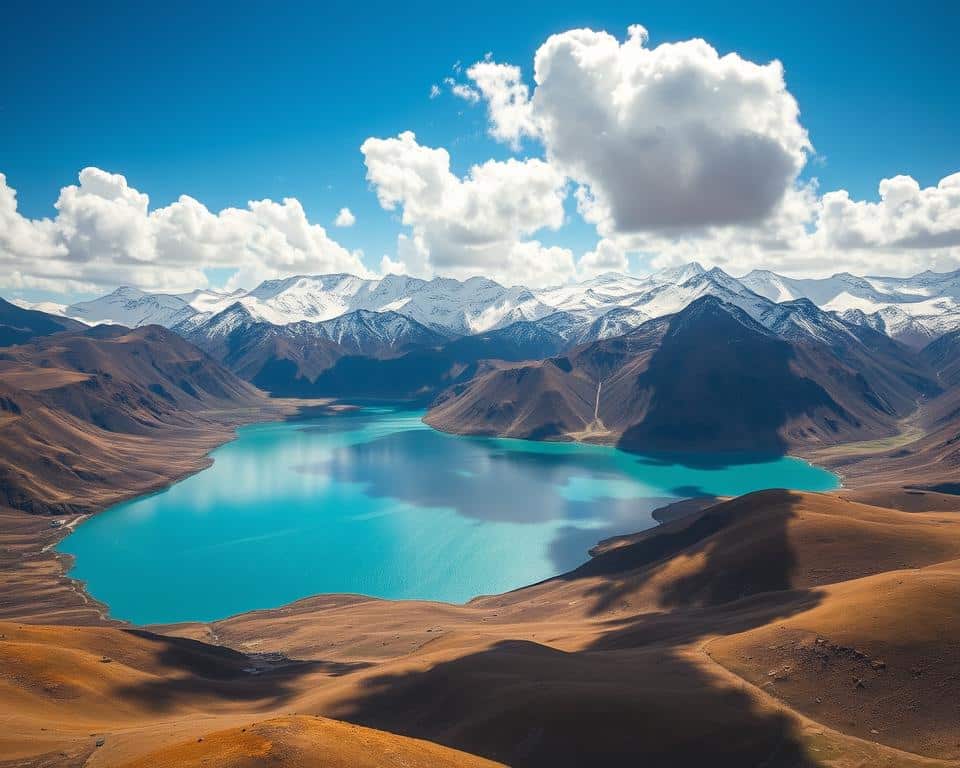Going on spiritual trips to sacred lakes and rivers is a rewarding journey. It connects us with the beauty of nature and cultural traditions across the globe. I’ll guide you through five sacred water sites that are of great importance to many communities and pilgrims.
Imagine the peaceful Namtso Lake in Tibet and the enchanting Yamdrok Tso Lake. These places have fascinated travelers for ages. Visit the Manasarovar Lake, which is close to the holy Mount Kailash, a major pilgrimage spot. There’s also the sacred River Ganga in India, famous for its 80 ghats in Varanasi, and the mystical sacred wells in Great Britain.
Each sacred water site is tied with myths, legends, and cultural practices. Taking a dip in these holy waters, walking around their serene borders, or just enjoying their stunning beauty offers moments of reflection and spirituality.
The Spiritual Significance of Namtso Lake
Namtso Lake is called the “celestial or sacred lake.” It’s a stunning saltwater lake, important in Tibet. It’s the second-largest in China and the highest saltwater lake in the world. It sits high at 4,718 meters.

A Glimpse into the Heart of Tibet
Near Lhasa, Namtso Lake is special in Tibetan Buddhism and culture. Its blue waters seem to join the sky. This view captivates pilgrims and tourists. Many come for the Namtso Lake pilgrimage, feeling its holy atmosphere. The site is near many Tibetan monasteries, adding to its charm.
Wildlife and Natural Beauty
Namtso Lake’s beauty comes with diverse life. It houses migratory birds and Tibetan sand foxes. In summer, its waters become crystal clear. This makes the lake stunning against the Nyenchen Tonglha mountains.
The best time to see Namtso Lake is from mid-April to October. Then, you can see its changing blue shades under good weather. It’s a key alpine lake among Tibet’s sacred sites.
The Mystical Waters of Yamdrok Tso Lake
In the heart of Tibet, Yamdrok Tso Lake showcases the stunning beauty of sacred lakes. It is huge, covering 10 million square hectares, making it one of Tibet’s largest lakes.

The lake has over 10 unique islands, each with its own ecosystems and communities. Its clear waters start freezing in mid-November. This transformation attracts photographers and nature lovers.
Panoramic Views and Tranquility
Yamdrok Tso Lake offers beautiful views and peaceful surroundings. It sits high, at 4,441 meters, and covers 638 square kilometers. The lake’s depth varies, reaching up to 59 meters at its deepest.
July to September is the best time to visit. A drive from Lhasa takes about 2-3 hours, offering incredible views. The area around the lake is perfect for grazing, thanks to its vast vegetation.
Tibetan Traditions and Culture
The lake is important for its cultural and religious significance. It supports local communities through fishing. The lake is home to unique fish species, vital for local traditions.
It also boasts the world’s highest-altitude hydropower plant. Nearby places like Samding Monastery show Tibet’s rich history and culture. Learn more with this detailed guide on Yamdrok Tso Lake.
Migratory birds find sanctuary here in winter, including swans and geese. The lake embodies the sacred essence of Tibetan lakes, being a natural and spiritual haven.
| Aspect | Details |
|---|---|
| Area | 10 million square hectares |
| Altitude | 4,441 meters |
| Depth | 20-40 meters (up to 59 meters) |
| Climate | Freezes by mid-November |
| Ecological Significance | High biodiversity with unique ecosystems |
| Cultural Sites | Samding Monastery |
| Best Visiting Months | July to September |
Yamdrok Tso Lake offers more than beauty. It invites you to experience nature, culture, and spirituality together.
Exploring the Sacred Manasarovar Lake
Manasarovar Lake stands out as one of the highest freshwater lakes globally. It is 4,590 meters (15,060 feet) above sea level and near the revered Mount Kailash. This sacred site attracts pilgrims worldwide because of its deep spiritual meaning.
Connection to Mount Kailash
The lake’s closeness to Mount Kailash makes it even more sacred. Mount Kailash pilgrimage followers feel a deep connection here. Legend says the lake was formed by a compassionate act involving rice-washing waters from King Mupeng. It lies in contrast with the neighboring Rakshas Tal, a lake surrounded by negative myths.
Local tales also talk about Airavata, a mythical white elephant, adding mysticism to the lake’s atmosphere.
Pilgrimage and Purification
Pilgrims walk 52 kilometers around the lake in a ritual called parikrama. This act shows physical strength and spiritual dedication. They believe the lake’s waters can purify the soul and bring blessings. Taking a holy dip here is said to wash away sins and negativity.
Visiting the Chiu Monastery offers stunning views of the lake, enhancing the experience. The best time for this journey is from early May to mid-October. Tours can last up to 15 days, allowing pilgrims to fully immerse in the sacredness of Manasarovar Lake and Mount Kailash.
| Feature | Details |
|---|---|
| Location | 4,590 meters (15,060 feet) above sea level |
| Parikrama | 52 kilometers |
| Tour Cost | USD 2069 – USD 2299 per person |
| Ideal Time to Visit | Early May to mid-October |
| Religious Significance | Hinduism, Buddhism, Jainism, Bon |
| Nearby Attractions | Chiu Monastery, Rakshas Tal |
The Spirituality of River Ganga and Great Britain’s Sacred Wells
The River Ganga is vital to India, stretching 2,704 kilometers (1,680 miles) from the Himalayas’ Gangotri glacier across North India. It is central to India’s spiritual life. By providing water for about 600 million people, it holds a special place. Sacred cities like Gangotri, Haridwar, and Varanasi are on its shores. Each city offers a rich mix of cultural and spiritual activities. For example, Haridwar is seen as the ‘Gateway to Gods.’ It’s one of the seven sacred cities where achieving moksha, or freedom from the cycle of life and death, is possible.
The Ganga’s importance goes beyond just being a river. It plays a key role in spiritual festivals like the Kumbh Mela, which happens every 12 years. Here, people from around the globe gather for spiritual fellowship, often taking Ganga water back for cleansing rituals. Despite its holy status, the river needs help. The Namami Gange project is investing over 328 billion rupees ($3.77 billion) to improve it. This includes adding 170 sewage plants and laying 5,211 kilometers of sewer pipes.
In Great Britain, ancient sacred wells offer another perspective on spiritual water practices. These wells, tied to Celtic and Christian traditions, show a lasting divine bond. For instance, St. Winifred’s Well in Wales has been a pilgrimage site for ages. It’s known for healing properties. Visitors hang cloth on nearby trees, symbolizing ailment release as the cloth decays.
Both India and the UK cherish their sacred water sites, highlighting a long-standing spiritual human connection. The Ganga’s flowing waters and the still, healing wells of Great Britain unite us. They show that spiritual fulfillment and physical well-being are linked beyond time and culture.
| River Ganga | Great Britain’s Wells | |
|---|---|---|
| Origin | Gangotri Glacier | Pre-Christian Celtic Traditions |
| Length | 2,704 kilometers (1,680 miles) | Fixed locations |
| Key Locations | Gangotri, Haridwar, Varanasi | St. Winifred’s Well, St. Nectan’s Glen |
| Population Served | 600 million people | Thousands of pilgrims |
| Major Festivals | Kumbh Mela | Various saint feast days |
Conclusion
Our journey through sacred water sites has taken us across lands filled with history and spirituality. We’ve visited places like Namtso Lake in Tibet, River Ganga in India, and mystical wells in Great Britain. Each site shows how deeply humans and water are connected.
These special waters call to those seeking wisdom, healing, and a connection to nature. Tibetan lakes and Lake Manasarovar near Mount Kailash offer peace and a place for rituals. The River Ganga and Britain’s sacred wells tell stories of faith and traditions that have lasted for ages.
Visiting these sites teaches us about different spiritual beliefs and shows why we must protect these waters for the future. Native American tribes, government agencies, and environmental groups work together to keep these places safe. They show us that sacred water sites are not just pretty spots. They are key to spirituality, culture, and taking care of our planet, impacting us deeply.

